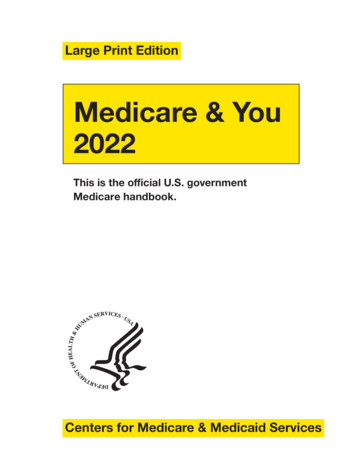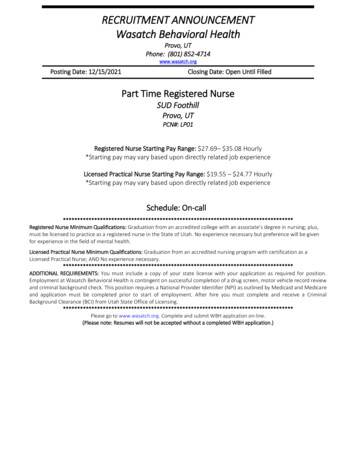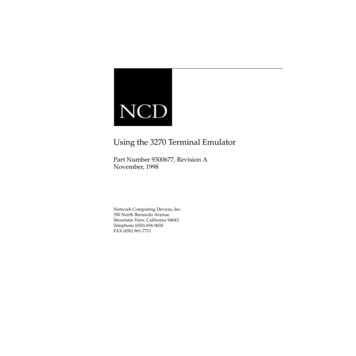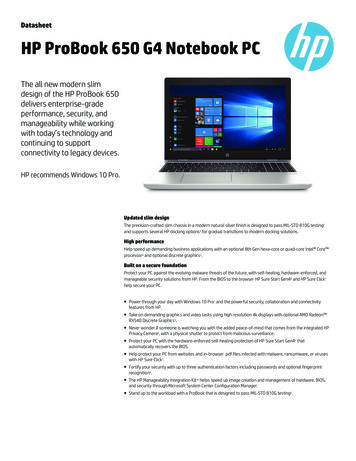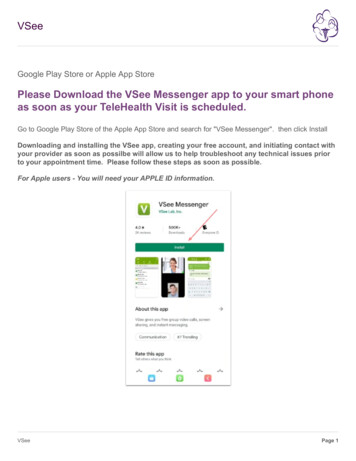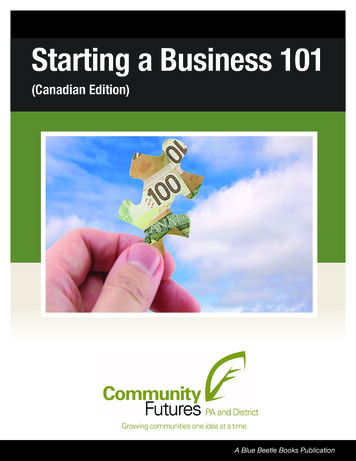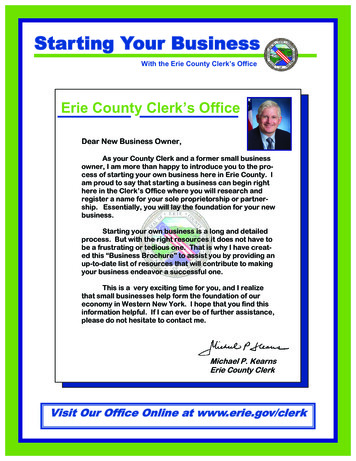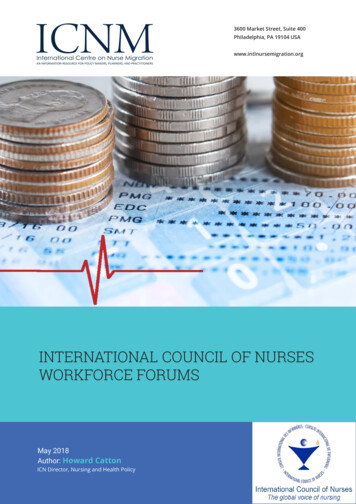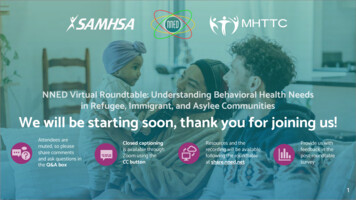
Transcription
We will be starting soon, thank you for joining us!Attendees aremuted, so pleaseshare commentsand ask questions inthe Q&A boxClosed captioningis available throughZoom using theCC buttonResources and therecording will be availablefollowing the roundtableat share.nned.netProvide us withfeedback in thepost-roundtablesurvey1
The views, opinions, and content expressed in this presentationdo not necessarily reflect the views, opinions, or policies of theOffice of Behavioral Health Equity (OBHE), the Substance Abuseand Mental Health Services Administration (SAMHSA), or the U.S.Department of Health and Human Services (HHS).2
National Network to EliminateDisparities in Behavioral HealthVIRTUAL ROUNDTABLEUnderstanding Behavioral Health Needs in Refugee,Immigrant, and Asylee Communities3
A network of over 5,200 individuals, includingmore than 1,300 community-basedorganizations striving for behavioral healthequity for for all individuals, families, andcommunities.Annie Guo VanDanVirtual Roundtable Coordinator, NNEDNational Facilitation CenterConsultant, Change Matrix4
Share commentsand ask questions inthe Q&A boxClosed captioningis available throughZoom using theCC button / FullLive TranscriptoptionResources and therecording will beavailable followingthe roundtable atshare.nned.netProvide us withfeedback in thepost-roundtablesurveyNational Network to EliminateDisparities in Behavioral Health5
Understanding Behavioral Health Needs in Refugee,Immigrant, and Asylee CommunitiesFinalThoughtsIntroductionsof PanelistsSetting theStagePanelistDiscussionResourcesNational Network to EliminateDisparities in Behavioral Health6
Understand the similarities and differences between refugees, immigrants, andasylees that affect mental health (e.g., trends, demographics, and othercharacteristics). Learn about the effects on refugee, immigrant, and asylee mental health andtrauma before, during, and after the migration process. Identify how communities can build culturally responsive, trauma-informedsystems and programs that effectively facilitate access to mental health care forrefugees, immigrants, and asylees. Discover how to build capacity and increase access for trauma informed andmental health care as well as support for refugees, immigrants, and asylees.National Network to EliminateDisparities in Behavioral Health7
Dr. Mary RoaryDirectorOffice of Behavioral Health Equity (OBHE)Substance Abuse and Mental Health Services AdministrationNational Network to EliminateDisparities in Behavioral Health8
Nima Sheth, MD, MPHSenior Medical AdvisorSAMHSA Center for Mental Health Services (CMHS)National Network to EliminateDisparities in Behavioral Health9
Understanding Behavioral Health Needs inRefugee, Immigrant, and AsyleeCommunitiesNima Sheth, MD, MPHSenior Medical Advisor, CMHSSubstance Abuse and Mental Health Services AdministrationU.S. Department of Health and Human Services
A Moment to Arrive 11
Overview Refugee cap increased from 15,000 to 62,500 Many categories of forced migration– Refugees– Asylum seekers, then asylees– Undocumented (may meet criteria for asylumseekers)– Survivors of trafficking– Special Immigrant (SIV) i.e. parolees– Unaccompanied Children12
Migrating due to persecution from 13RaceReligionNationalityMembership in a particular social groupPolitical opinionFleeing Violence
Source: HumanRights First, 2014
Figure 1. Annual Refugee Resettlement Ceiling and Number of Refugees Admitted to theUnited States, FY 1980-202115Source: Migration Policy Institute, 2021
Regions of Origin of U.S. Refugee Arrivals, FY 2000-20Source: Migration Policy Institute, 202116
Figure 4. Refugee Arrivals by Initial U.S. State of Residence, FY 2010-20Source: Migration Policy Institute, 202117
Figure 7. Age and Gender of Refugees Admitted to the United States, FY 2010-2018Source: Migration Policy Institute, 2021
We are all Fragile and Resilient19
Stress Injury Basics20Source: Watson, Patricia presentation 2020
Core Areas Impacted by TraumaFeelings of helplessness/sense of control– Intimacy– Self esteem– Safety– Trust–(Source: Resick et al, 2017)21
The Stress Continuum Model22Source: Watson, Patricia presentation, 2020
Post-Migration Social Determinants of Mental Health Pre-migration & Migration trauma Post-migration factors moderate ability to recover from pre-migration andmigration ingLanguage Skills and InterpretationSocial Support and Social IsolationDiscriminationResettlement and integrationAsylum Seeking Process
Common Social Determinants of Mental Health for Asylum SeekersEmerging ModelSource: Sheth, NimaNARHC Conference Presentation, 2018
Full References 25Human Rights First . (2014, June 5). Asylum Overview: How Refugees Get to the Unites States.In Human Rights First . Retrieved from erview-how-refugees-get-united-statesMonin, K., Batalova, J., & Lai, T. (2021, May 13). Refugees and Asylees in the United States.In Migration Policy Institute . Retrieved from ndasylees-united-states-2021MPI analysis of State Department WRAPS data, as cited -and-asylees-united-states-2021#top-statesResick, Patricia, et al. Cognitive Processing Therapy for PTSD. The Guilford Press, 2017.U.S. Departments of State, Homeland Security, and Health and Human Services, “Proposed RefugeeAdmissions for Fiscal Year,” various years; Migration Policy Institute (MPI) analysis of StateDepartment's Worldwide Refugee Admissions Processing System (WRAPS) data, available online, ascited in lingWatson, Patricia. The Swartz Center Webinar Series, Caring for Yourself & Others During the COVID19 Pandemic: Managing Healthcare Workers’ Stress. rtz-Center-Watson-SFA-Final-PDF.pdf
Thank YouSAMHSA’s mission is to reduce the impact of substanceabuse and mental illness on America’s communities.www.samhsa.gov1-877-SAMHSA-7 (1-877-726-4727) 1-800-487-4889 (TDD)26
Cecily Peeples RodriguezHyojin Im, PhD, MSW, MAManager of Applied ResearchVirginia Tech School of Public andInternational AffairsAssociate ProfessorVirginia Commonwealth UniversitySchool of Social WorkKathi AndersonExecutive DirectorSurvivors of Torture, InternationalNational Network to EliminateDisparities in Behavioral Health27
Why is there migration and who arethe populations?Cecily Peeples RodriguezHyojin Im, PhD, MSW, MAKathi AndersonAnnie Guo VanDan, MBANational Network to EliminateDisparities in Behavioral Health28
ABOVE ALL ELSE Every immigrant has a unique story. Many ofthese tales include overcoming tremendousobstacles in order to establish themselves inthe United States. Once finally here,interaction with the public child welfaresystem, and “the authorities”, will create a highlevel of anxiety, especially if it is perceived thatit will jeopardize a tenuous stay in the UnitedStates. To provide relevant services to migrantfamilies, we must understand this.HOW? 22 kinds of visas: Work Visas, Marriage Visas, FamilyVisas/Petitions, Tourist Visas, Student Visas, etc. Refugee or TPS Without inspection/informal migrationWHY?Migration is one of the most constant characteristicsof human history. Most large migrations are theresult of both pressures to leave the point ofdeparture and attraction towards the destination. Push Factors may be: Political. Warfare, violence, persecution, forcedmigration, marginalization. Economic. Poverty, lack of opportunities, landscarcity. Climatic/environmental. Pull factors may be: Political Economic Cultural/linguistic ties Kinship/social networks Labor recruitmentCecily Peeples RodriguezNational Network to EliminateDisparities in Behavioral Health29
Immigrants and refugeesexperience multiple traumaticevents over the course oftheir lives. Many experience trauma intheir country of origin, overthe course of their migration,and once they’ve beenresettled. Post-Traumatic StressDisorder (PTSD) is extremelycommon among the refugeepopulation.Cecily Peeples RodriguezNational Network to EliminateDisparities in Behavioral Health30
Immigrants, Refugees and Mental HealthContext- OverseasContext– in the US All resettled refugees experienceanxiety/stress related to actual travel/resettling process Re-traumatization may occur over and overduring the resettlement phase WHO has established that more than 50% ofrefugees have mental health challenges Many refugees have underlying trauma fromtheir migration experience Racism as an additional stressor contributingtowards mental health High incidence of depression Impact of delayed attention-treatment Most refugee source countries do not haveformal mental health systems Culture shock phenomena War, torture, witness of violence and posttraumatic stress syndrome Increased recognition by formal mental healthsystems towards the informal mental healthwork undertaken by NGOs Stigma and discrimination associated withmental health illness Formal and informal mental health systems andsupports exists with growing movementtowards more culturally responsive servicesCecily Peeples RodriguezISS of BCNational Network to EliminateDisparities in Behavioral Health31
What experiences of trauma do thesecommunities face during theirmigration process and resettlement?What are the effects on their mentalhealth?Cecily Peeples RodriguezHyojin Im, PhD, MSW, MAKathi AndersonAnnie Guo VanDan, MBANational Network to EliminateDisparities in Behavioral Health32
Survivors of Torture,International (SURVIVORS)Established in 1997, San DiegoMission Statement: Facilitates the healing of torture survivors and theirfamilies; Educates professionals and the public abouttorture and its consequences; Advocates for torture survivors and the abolition oftorture.
Clients and ServicesClientsServices Asylum seekers, refugees,humanitarian parolees, others Adults and children 90 countries 60 languages Mental Health Case Management Medical Support Legal Support
Resources International RehabilitationCouncil for Torture Victims(IRCT) www.irct.org National Consortium ofTorture Treatment Programs(NCTTP) www.thencttp.orgSurvivors of Torture, International(SURVIVORS)www.notorture.orgKathi Anderson, Executive Director(619) 278-2407kanderson@notorture.org
What are the immediate mental healthconcerns that asylum seekers,refugees and immigrants are facing?How has the pandemic impacted thesecommunities?Cecily Peeples RodriguezHyojin Im, PhD, MSW, MAKathi AndersonAnnie Guo VanDan, MBANational Network to EliminateDisparities in Behavioral Health36
Border Closure &Admission of AsylumSeekersAccess deniedNo COVID-related restrictions imposedRestrictions apply with exceptions forasylum-seekersPending dataNNED Roundtable, February 23, 2022Source: UNHCR – Temporary Measures and Impact on Protection (2022)Hyojin Im, VCU SSW37
COVID-19Pandemic andRefugee &ImmigrantMental HealthNNED Roundtable, February 23, 2022 Newly arrived families/individuals Barriers to healthcare – physical, psychological,economic, social barriers Cumulative stress and mental health burdens. Impeded coping system Xenophobia and stigmatization Dis-/misinformation Worries about families left behind Precarious work Isolation – physical and psychological sense ofconfinement Fear in uncertaintyHyojin Im, VCU SSW38
What barriers do individuals face tosuccessfully arriving and starting theirlives in the US?Cecily Peeples RodriguezHyojin Im, PhD, MSW, MAKathi AndersonAnnie Guo VanDan, MBANational Network to EliminateDisparities in Behavioral Health39
What strategies can providers use toprovide culturally responsive, traumainformed care?Cecily Peeples RodriguezHyojin Im, PhD, MSW, MAKathi AndersonAnnie Guo VanDan, MBANational Network to EliminateDisparities in Behavioral Health40
Great Ideas! Health Brigade – warm handoff/integrated care Behavioral Health Interpreter Training Program – workforce development Women’s Initiative – Psycho-social, peer- and community-based interventionsfor immigrants and refugees USCRI Mental Health Awareness Training ProgramCecily Peeples RodriguezISS of BCNational Network to EliminateDisparities in Behavioral Health41
Intensive, specialized care andpsychiatric treatment for those withsevered mental illness and disordersRefugee trauma likely increases a risk formental illness and exacerbatesuntreated psychiatric problemsTrauma-focused mental healthservices are provided to refugeeswith RHS-15 scores of 12 or moreRefugees’ experiences of traumaoften lead to common mentalhealth disordersCommunity-based programs helprestore and strengthen communitysupports for stress copingRefugee families and communitysupport systems have beenchallenges during migrationTrauma-informed &culture-sensitive care isintegrated intoresettlement servicesRefugee newcomers needbasic services foradjustment to new homeNNED Roundtable, February 23, 2022Hyojin Im, VCU SSW42
TraumaInformedCareCross-Cultural Trauma-Informed Care(CC-TIC)Coordinated &Collaborative CareMental & Behavioral Health CareCommunity Healing PartnershipCultureCenteredCarePsycho-Social Services(Non-MH)NNED Roundtable, February 23, 2022Refugee/ImmigrantCommunities (Peers)Hyojin Im, VCU SSW43
1Join the Network!https://nned.net/join2Alina TaniuchiNational Network to EliminateDisparities in Behavioral Health44
1Connect with Community-BasedOrganizations in Partner Central*https://nned.net/members2*NOTE: You must be a logged-in NNED member to access Partner CentralAlina TaniuchiNational Network to EliminateDisparities in Behavioral Health45
1Find Behavioral Health FundingOpportunities2https://nned.net/fundingAlina TaniuchiNational Network to EliminateDisparities in Behavioral Health46
1Explore NNEDshare!https://share.nned.net2Alina TaniuchiNational Network to EliminateDisparities in Behavioral Health47
What training and learningopportunities are available forproviders to build capacity around thistopic and for working with thiscommunity?Cecily Peeples RodriguezHyojin Im, PhD, MSW, MAKathi AndersonAnnie Guo VanDan, MBANational Network to EliminateDisparities in Behavioral Health48
Resources: Training & Learning Materials Professional-Led Training Mental Health First Aid (MHFA)Training Cross-Cultural Trauma-InformedCare (CC-TIC) Workshop Web-Based Training & Toolkits Psychological First Aid (PFA) Question Persuade Response(QPR) Refugee and Immigrant CoreStressors Toolkit (RICST) NCTSN Online ResourcesNNED Roundtable, February 23, 2022 Bridging Refugee Youth andChildren’s Services (BRYCS) Refugee Health TechnicalAssistance Center Non-Web-Based Tools CVT’s Psychoeducationcurriculum Pathway2Wellness Community Wellness Workshop(CWW) - Request form USCRI’s Nutrition Education MHPSS CurriculumHyojin Im, VCU SSW49
Any other questions from the Q&Anot yet addressed?Cecily Peeples RodriguezHyojin Im, PhD, MSW, MAKathi AndersonAnnie Guo VanDan, MBANational Network to EliminateDisparities in Behavioral Health50
How have you been able to stay inthis work for so long?What keeps you going?Cecily Peeples RodriguezHyojin Im, PhD, MSW, MAKathi AndersonAnnie Guo VanDan, MBANational Network to EliminateDisparities in Behavioral Health51
THANK YOU FOR JOINING US TODAY!To view resources related to this webinar andthe recording, visit share.nned.netQuestions? Email connect@nned.netPlease provideyour feedback inthe survey!Join the NNED to join us for futurelearning opportunities: nned.net/joinNational Network to EliminateDisparities in Behavioral Health52
https://bit.ly/3ICbjrN53
NNED Roundtable, February 23, 2022 Hyojin Im, VCU SSW 42 Refugee trauma likely increases a risk for mental illness and exacerbates untreated psychiatric problems Refugees' experiences of trauma often lead to common mental health disorders Refugee families and community support systems have been challenges during migration Refugee newcomers need
